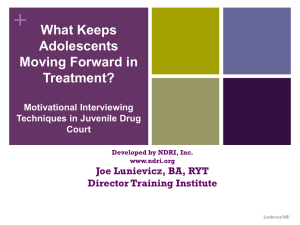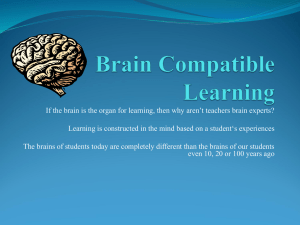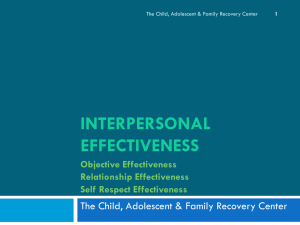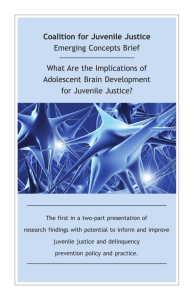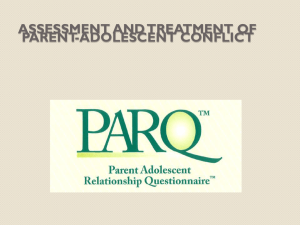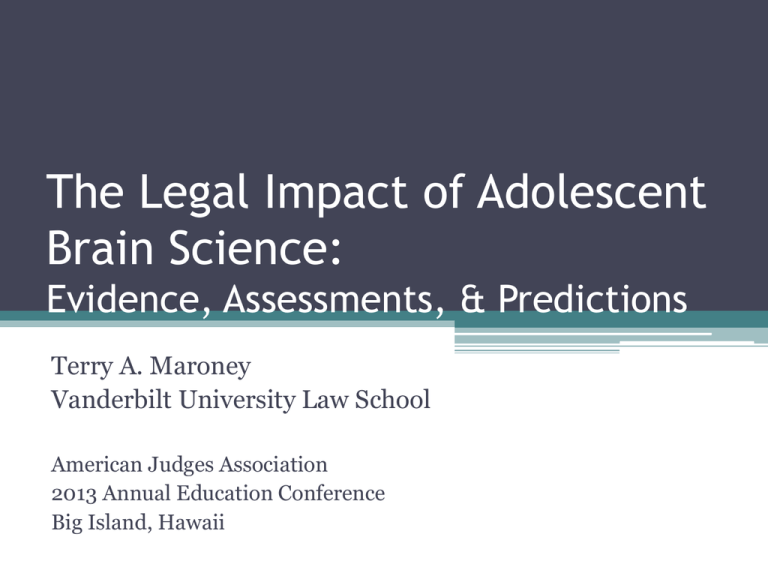
The Legal Impact of Adolescent
Brain Science:
Evidence, Assessments, & Predictions
Terry A. Maroney
Vanderbilt University Law School
American Judges Association
2013 Annual Education Conference
Big Island, Hawaii
Presentation overview
• Background: The basics of adolescent brain
science; tracing its migration out of the
laboratory and into legal theory & practice
Evidence & Assessment: What kinds of claims are
being made on the basis of adolescent brain
science, what is happening to them, and why?
• Predictions: What role is the science likely to play
in juvenile justice going forward?
Basics of Adolescent Brain Science
• Main argued differences relative to adult brains
▫ Lesser degree of myelination, esp. in
frontal cortex
▫ Neural exuberance followed by synaptic
pruning
▫ Differential recruitment patterns, e.g.,
greater recruitment of amygdala relative
to frontal regions
Myelination
Pruning
Normal development of the prefrontal cortex from age 5 20. Red indicates more gray matter, blue
less. Gray matter wanes in a back to front wave as the brain matures and neural connections are
pruned and higher-order functions developed.
Source: Gogtay, N., et al., Dynamic Mapping of Human Cortical Development during Childhood through Early Adulthood, Proceedings of the National Academy of
Sciences, 101(21):8174-8179, May 25 2004
Differential recruitment
• “In a recent study mapping differences between the brains of adults and
teens, Yurgelun-Todd put teenage and adult volunteers through a MRI and
monitored how their brains responded to a series of pictures [of fearful
faces]. The volunteers were asked to discern the emotion. The results were
surprising. All the adults identified the emotion as fear, but many of the
teenagers saw something different, such as shock or anger. When she
examined their brain scans, Todd found that the teenagers were using a
different part of their brain when reading the images.”
•
http://www.pbs.org/wgbh/pages/frontline/shows/teenbrain/interviews/todd.html
Teens (left) used less of the prefrontal (upper) region than adults (right) when reading emotion.
Adolescent Brain Science takeaway
• Teen brains are structurally and functionally
different from those of both children and adults
• The correspondence between neuroscience and
psychology suggests a neural underpinning for
teens’ typical behavioral traits
• Normal brain development creates greater
capacity for maturity of thought, emotion, and
behavior
Adolescent Brain Science:
Trajectory from laboratory to law
Adolescent brain science (ABS) adopted by
juvenile advocates and theorists by early 2000’s;
relied on heavily in briefs & oral argument in
Roper
Roper (2004): “scientific and sociological
studies … tend to confirm” common knowledge
that juveniles are relatively immature
Graham (2010): “Developments in psychology
and brain science continue to show fundamental
differences between juvenile and adult minds …
parts of the brain involved in behavior control
continue to mature through late adolescence.”
Adolescent Brain Science:
Trajectory from laboratory to law
Range of post-Roper & Graham legal claims
• Sentencing
▫ Invalidity of schemes; choice of sentence within
range, individual mitigation
• Transfer to adult court
▫ Invalidity of schemes; individual transfer decisions
• Competence, including ability to waive rights
▫ Miranda, consent searches, waiver of counsel
• Mental states
▫ Inability to form mens rea; how recklessness and
negligence should be construed
Evidence & Assessments
Legal impact of ABS claims appears minor
• When positively cited by courts,
▫ one reason among many,
▫ usually in support of a general proposition about
youth as a class,
▫ buttressing behavioral studies & lay observation
• Frequently deemed legally irrelevant,
▫ foreclosed by doctrine and/or legislative choices,
▫ failing to inform individualized assessment, or
▫ duplicative of other evidence as to immaturity
• Sometimes rejected on merits,
▫ where in conflict with record evidence
Evidence & Assessments
Positively cited by courts in support of general
propositions about youth as a class …
• Roper, Graham, JDB, & Miller: “three general
differences”
• AL: ABS could be relevant to argument that
“developmental immaturity” should be recognized as a
basis for sentencing mitigation under state law
…but does not appear outcome determinative
• NV family court: ABS is one of 5 reasons to invalidate
juvenile sex offender registration scheme
• WI Supreme Court, Abrahamson concurrence: ABS is
reason 3 of 8 to require parental presence at juvenile
interrogations
Evidence & Assessments
Frequently deemed legally irrelevant because of …
doctrine…
• NM: challenge to juvenile’s ability to
premeditate & form specific intent to kill
▫ Even if true, would amount to “diminished
capacity” defense, not allowed under state law
… and legislative choices
• CT: refusal to define “reasonable person” for
duress defense by reference to adolescent traits
▫
Legislature had chosen an “objective” standard
• MN: science does not override legislative
transfer scheme
Evidence & Assessments
Frequently deemed legally irrelevant because of …
failing to inform individualized assessment
• CA (Andy Williams):
▫ School shooter had MRI taken of brain pre-plea,
had never been analyzed
▫ Neither MRI nor expert testimony about ABS
likely to generate relevant evidence as to Williams’
mental state
▫ Individual examination & diagnosis by
psychiatrist both more relevant and sufficient
Evidence & Assessments
Frequently deemed legally irrelevant because of …
adding little to other evidence or to “common
sense”
• Del.: “typical adults can be counted on to
understand that young people make illconsidered and bad judgments,” even if they
don’t understand the “physiological
underpinnings” for that behavior
• WI: court had considered “youth” as a
sentencing mitigator, so did not additionally
need to consider evidence of brain development
Evidence & Assessments
Sometimes rejected on merits where in conflict
with record evidence
• SC (Pittman): ABS cannot show juvenile’s
inability to premeditate, plan, deceive, where
independent evidence of those actions
• Del.: ABS expert testified that juveniles’ brain
immaturity manifests in poor planning and
foresight; neuropsychological tests showed high
levels of planning and foresight
Predictions
Juvenile justice will continue to be transformed
post-Roper & Graham, but not primarily because
of adolescent brain science
• Maximum weight it can bear: in support of
general propositions about youth as a group
▫ Pointed, scientific, 21st-century way to articulate
what is different about youth
▫ Very persuasive at high level of generality
▫ one reason among many to recommit to a
balanced system of justice for juveniles
• Dangers of early overemphasis, overreliance
For more information
The False Promise of Adolescent Brain Science in Juvenile
Justice, 85 NOTRE DAME L. REV. 89 (2009)
Adolescent Brain Science after Graham v. Florida, 86
NOTRE DAME L. REV. 765(2011)
The Once and Future Juvenile Brain, in CHOOSING THE
FUTURE FOR AMERICAN JUVENILE JUSTICE (Franklin E.
Zimring & David S. Tanenhaus eds., forthcoming 2014)
• In your conference materials
terry.maroney@vanderbilt.edu
http://ssrn.com/author=447138






